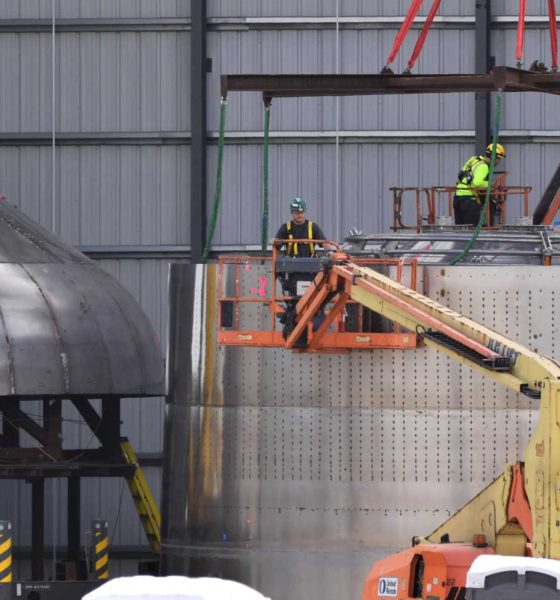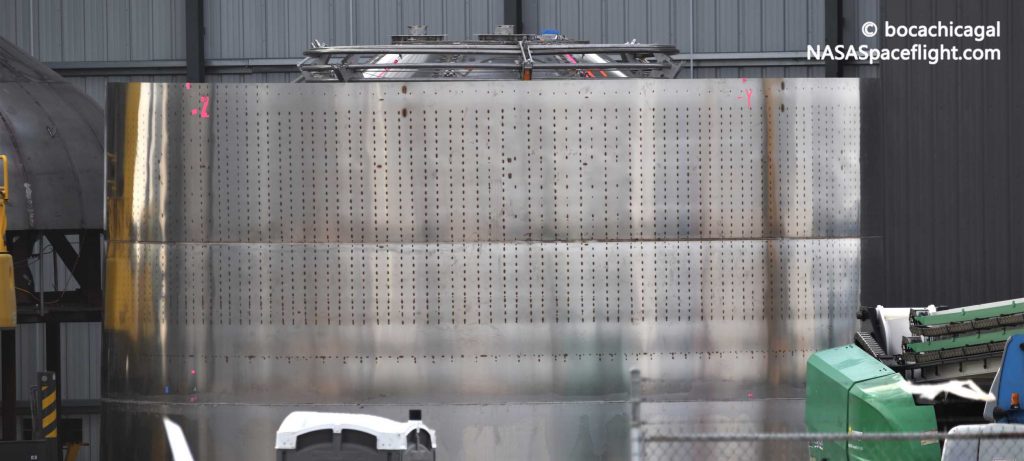

News
SpaceX shrugs off Starship implosion and gets back to work as Elon Musk talks next steps
SpaceX has shrugged off the catastrophic implosion of its first serial Starship prototype (SN01) and begun stacking sections of the next ship (SN02) while CEO Elon Musk talks next steps for the next-generation rocket program.
By now, it’s reasonably clear that the demise of Starship SN01’s tank and engine section came as a bit of surprise to SpaceX itself, while it assuredly shocked non-employees and local residents who happened to be watching on eve of the anomaly. CEO Elon Musk himself appears to have expected different results, noting that – thankfully – the likely source of the Starship’s unforeseen failure had already been determined.
Despite the apparent setback, it appears that SpaceX won’t have to wait long at all to continue its uniquely ‘hardware-rich’ Starship test campaign. With a workforce now several hundred strong and a great deal of hands-on and strategic experience gained from building Starships Mk1 and SN01, SpaceX is now practically churning out parts for future Starship SNxx prototypes. Most notably, Starship SN01’s predecessor is potentially just a few days away from being stacked into a finished tank section, hinting at the almost unfathomably speed that SpaceX is able to build full-scale vehicles even in early days of the program.
Three days after Starship SN01’s spectacular implosion and unintentional ‘launch’, SpaceX CEO Elon Musk took to Twitter to share a video captured by local Boca Chica Village resident ‘bocachicagal’ and posted by NASASpaceflight.com. Attached above, Mary’s video offers an incredibly vivid view of the rocket’s violent demise while further revealing the apparent location where the failure started – Starship SN01’s engine section and thrust structure.
Confirming suspicions, Musk quickly implied that the Starship’s failure originated in or around its thrust structure (‘thrust puck’), further noting that Starship SN02 – already in the middle of production – would be “stripp[ed]…to [the] bare minimum to test the thrust puck to dome weld.” In essence, it sounds like Starship SN02 will become SpaceX’s third intentional “test tank”, following in the footsteps of two small Starship tanks built and pressurized to failure to verify the quality of Starship manufacturing.


Starship SN02’s thrust structure design already appears to be a departure from SN01’s apparently unsuccessful iteration. Given that it was already partially completed before Starship SN01 failed during testing, it’s possible that SpaceX will attempt to reinforce the SN02 thrust structure, but the company may have already implemented upgrades before its engineers had the benefit of hindsight from February 28th’s test.
Regardless of what happens to Starship SN02, the fact that SpaceX is apparently building full-scale, (mostly) functional Starship tank sections from raw materials to the launch pad in a matter of a few weeks is incredibly encouraging for the next-generation rocket development program. As an external observer, it’s certainly disappointing to see an impressive piece of rocket hardware shredded in an evening after weeks of work, but that speed – and SpaceX’s willingness to accept failures at the scale of SN01 – suggests that each prototype is almost unfathomably cheap. Unofficial estimates peg the cost of SN01-like Starship prototypes at just several million dollars apiece, while the cost of the raw steel itself is so low that it might as well be negligible.

Even if it takes SpaceX 5-10 SN01-class failures to mature its South Texas rocket factory into a reliable machine and get to a point of stability and confidence with suborbital Starship flights, the total cost of that trial and error is comically insignificant relative to almost any other rocket development program in history. To be clear, SpaceX might benefit from going a little slower and refining Starship’s prototype design, but it’s impossible to know from an armchair. For now, the best available advice is to simply enjoy the show and view each potential test failure as just another small step along the path to Mars.
Check out Teslarati’s Marketplace! We offer Tesla accessories, including for the Tesla Cybertruck and Tesla Model 3.

Investor's Corner
Tesla stock closes at all-time high on heels of Robotaxi progress

Tesla stock (NASDAQ: TSLA) closed at an all-time high on Tuesday, jumping over 3 percent during the day and finishing at $489.88.
The price beats the previous record close, which was $479.86.
Shares have had a crazy year, dipping more than 40 percent from the start of the year. The stock then started to recover once again around late April, when its price started to climb back up from the low $200 level.
This week, Tesla started to climb toward its highest levels ever, as it was revealed on Sunday that the company was testing driverless Robotaxis in Austin. The spike in value pushed the company’s valuation to $1.63 trillion.
Tesla Robotaxi goes driverless as Musk confirms Safety Monitor removal testing
It is the seventh-most valuable company on the market currently, trailing Nvidia, Apple, Alphabet (Google), Microsoft, Amazon, and Meta.
Shares closed up $14.57 today, up over 3 percent.
The stock has gone through a lot this year, as previously mentioned. Shares tumbled in Q1 due to CEO Elon Musk’s involvement with the Department of Government Efficiency (DOGE), which pulled his attention away from his companies and left a major overhang on their valuations.
However, things started to rebound halfway through the year, and as the government started to phase out the $7,500 tax credit, demand spiked as consumers tried to take advantage of it.
Q3 deliveries were the highest in company history, and Tesla responded to the loss of the tax credit with the launch of the Model 3 and Model Y Standard.
Additionally, analysts have announced high expectations this week for the company on Wall Street as Robotaxi continues to be the focus. With autonomy within Tesla’s sights, things are moving in the direction of Robotaxi being a major catalyst for growth on the Street in the coming year.
Elon Musk
Tesla needs to come through on this one Robotaxi metric, analyst says
“We think the key focus from here will be how fast Tesla can scale driverless operations (including if Tesla’s approach to software/hardware allows it to scale significantly faster than competitors, as the company has argued), and on profitability.”

Tesla needs to come through on this one Robotaxi metric, Mark Delaney of Goldman Sachs says.
Tesla is in the process of rolling out its Robotaxi platform to areas outside of Austin and the California Bay Area. It has plans to launch in five additional cities, including Houston, Dallas, Miami, Las Vegas, and Phoenix.
However, the company’s expansion is not what the focus needs to be, according to Delaney. It’s the speed of deployment.
The analyst said:
“We think the key focus from here will be how fast Tesla can scale driverless operations (including if Tesla’s approach to software/hardware allows it to scale significantly faster than competitors, as the company has argued), and on profitability.”
Profitability will come as the Robotaxi fleet expands. Making that money will be dependent on when Tesla can initiate rides in more areas, giving more customers access to the program.
There are some additional things that the company needs to make happen ahead of the major Robotaxi expansion, one of those things is launching driverless rides in Austin, the first city in which it launched the program.
This week, Tesla started testing driverless Robotaxi rides in Austin, as two different Model Y units were spotted with no occupants, a huge step in the company’s plans for the ride-sharing platform.
Tesla Robotaxi goes driverless as Musk confirms Safety Monitor removal testing
CEO Elon Musk has been hoping to remove Safety Monitors from Robotaxis in Austin for several months, first mentioning the plan to have them out by the end of 2025 in September. He confirmed on Sunday that Tesla had officially removed vehicle occupants and started testing truly unsupervised rides.
Although Safety Monitors in Austin have been sitting in the passenger’s seat, they have still had the ability to override things in case of an emergency. After all, the ultimate goal was safety and avoiding any accidents or injuries.
Goldman Sachs reiterated its ‘Neutral’ rating and its $400 price target. Delaney said, “Tesla is making progress with its autonomous technology,” and recent developments make it evident that this is true.
Investor's Corner
Tesla gets bold Robotaxi prediction from Wall Street firm
Last week, Andrew Percoco took over Tesla analysis for Morgan Stanley from Adam Jonas, who covered the stock for years. Percoco seems to be less optimistic and bullish on Tesla shares, while still being fair and balanced in his analysis.

Tesla (NASDAQ: TSLA) received a bold Robotaxi prediction from Morgan Stanley, which anticipates a dramatic increase in the size of the company’s autonomous ride-hailing suite in the coming years.
Last week, Andrew Percoco took over Tesla analysis for Morgan Stanley from Adam Jonas, who covered the stock for years. Percoco seems to be less optimistic and bullish on Tesla shares, while still being fair and balanced in his analysis.
Percoco dug into the Robotaxi fleet and its expansion in the coming years in his latest note, released on Tuesday. The firm expects Tesla to increase the Robotaxi fleet size to 1,000 vehicles in 2026. However, that’s small-scale compared to what they expect from Tesla in a decade.
Tesla expands Robotaxi app access once again, this time on a global scale
By 2035, Morgan Stanley believes there will be one million Robotaxis on the road across multiple cities, a major jump and a considerable fleet size. We assume this means the fleet of vehicles Tesla will operate internally, and not including passenger-owned vehicles that could be added through software updates.
He also listed three specific catalysts that investors should pay attention to, as these will represent the company being on track to achieve its Robotaxi dreams:
- Opening Robotaxi to the public without a Safety Monitor. Timing is unclear, but it appears that Tesla is getting closer by the day.
- Improvement in safety metrics without the Safety Monitor. Tesla’s ability to improve its safety metrics as it scales miles driven without the Safety Monitor is imperative as it looks to scale in new states and cities in 2026.
- Cybercab start of production, targeted for April 2026. Tesla’s Cybercab is a purpose-built vehicle (no steering wheel or pedals, only two seats) that is expected to be produced through its state-of-the-art unboxed manufacturing process, offering further cost reductions and thus accelerating adoption over time.
Robotaxi stands to be one of Tesla’s most significant revenue contributors, especially as the company plans to continue expanding its ride-hailing service across the world in the coming years.
Its current deployment strategy is controlled and conservative to avoid any drastic and potentially program-ruining incidents.
So far, the program, which is active in Austin and the California Bay Area, has been widely successful.








